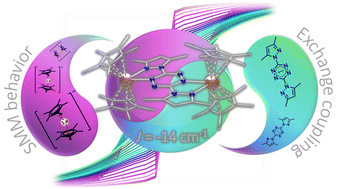Strong magnetic exchange coupling in Ln2 metallocenes attained by the trans-coordination of a tetrazinyl radical ligand†
Abstract
A combination of high-performing lanthanide metallocenes and tetrazine-based radical ligands leads to a new series of radical-bridged dinuclear lanthanide metallocenes; [(Cp*2LnIII)2(bpytz˙−)][BPh4] (where Ln = Gd (1), Tb (2), Dy (3) and Y (4); Cp* = pentamethylcyclopentadienyl; bpytz = 3,6-bis(3,5-dimethyl-pyrazolyl)-1,2,4,5-tetrazine). The formation of the radical species is achieved via a controlled, stepwise synthesis and verified in all complexes by X-ray crystallography and SQUID magnetometry, as well as EPR spectroscopy of 4. Through the judicious choice of the Cp* ancillary ligands and by taking advantage of the steric effects imposed by their bulkiness, we were able to promote the trans coordination mode of the bpytz˙− radical anion that enables stronger magnetic exchange coupling compared to the cis fashion. This yields a JGd–rad = −14.0 cm−1 in 1, which is the strongest exchange coupling observed in organic monoanionic radical-bridged lanthanide metallocene systems. The strong Ln-rad exchange coupling was further confirmed by high-frequency EPR (HF-EPR) spectroscopy and broken-symmetry (BS) density functional theory (DFT) calculations. This combined with the highly anisotropic nature of TbIII and DyIII ions in 2 and 3, respectively, leads to strong SMM behavior and slow relaxation of the magnetization at zero fields.



 Please wait while we load your content...
Please wait while we load your content...